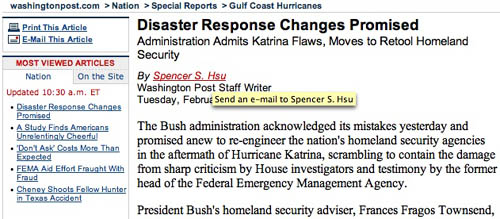Facing a far from certain future, the New York Times continues to innovate impressively, announcing yesterday a new venture in distance learning with six initial partner universities: the New York Times Knowledge Network. Among other things, this could help pave the way to a long overdue rethinking of textbooks.
Selected passages from Scott Jaschik in Inside Higher Ed:
Some of the online courses will also make use of Times content that is a centerpiece of the services being offered to colleges, on enrollment-based subscription plans. These packages will provide access to special packages of content -? summaries of articles, interactive maps, video, audio, graphs -? on a wide range of topics (the European Union, nanotechnology and so forth). Professors at institutions that subscribe would be able to make customized course Web pages, with their own content alongside these content packages. For the many topics covered on which there are updates, professors can elect to have material updated automatically or at the end of the semester.
…
Robert L. Caret, president of Towson [one of the universities participating in the Times network], said he sees the materials providing “a broader, richer educational experience to students.” He said he saw this as something Towson could do at minimal cost. The university plans to charge students the equivalent of a laboratory fee, maybe $100 to $150, for access to the Times materials. But he said student costs should not go up because he sees the online resources replacing some textbooks, and replacing them with material that is more current and more interactive.
…
Nudelman [NYT director of education] said that the Times did not view its new offerings as course-management systems in competition with Blackboard or others, but as complements to those systems. Nudelman said that the target audience for the Times for these services would be every higher education institution. “This is an absolute fit. We’ve been doing work in education for over 70 years, and this fits in with our ability to partner with the universities, colleges, and K-12, to work on distribution of information, news and entertainment, and to convene communities around credible content,” she said.
And in a comment on the IHE piece, Michael P. Lambert, Executive Director at Distance Education and Training Council, points out that the Times‘ new effort falls in a long line of continuing education programs through newspapers:
The Times entry to the distance learning field is a continuation of a tradition of “courses by newspaper” first launched in the U.S. by the Editor of the Mining Herald in Scranton, PA, in 1890. Thomas J. Foster started investigating coal mine accidents in his newspaper, and this led to a series of “instructional articles” in mine safety. His “course by newspaper” hit a nerve with the public. Soon, Foster was getting mail from around the world on the topic of mine safety, and from this editorial platform, he launched the International Correspondence Schools (ICS). By 1895, ICS had enrolled over 10,000 people in his correspondence programs, and by 1910, over 1.3 million, by 1945, over 5 million, and by 2007, over 13 million have enrolled. Today, ICS’ pioneering work in “continuing education for everyone” is carried on faithfully by Penn Foster College of Scranton, a DETC accredited distance learning institution. So there is a long and noble tradition of newspapers in bringing learning opportunities to the world, and the New York Times is a welcome entry to this tradition.

